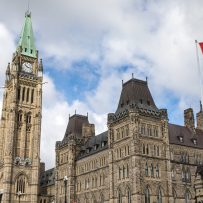A QUARTER OF EMPLOYED CANADIANS NOW WORK FOR THE GOVERNMENT

Canadian employment doesn’t look like it moved much, but under the surface was a giant shift. Statistics Canada (Stat Can) data shows the number of jobs virtually unchanged in July, growing 1.7% (+345k jobs) over the past year. As a result, the unemployment rate was also flat at 6.4%, adding 0.9 points from last year. Mostly boring until you dive into the details that show the public sector now accounts for most jobs, overseeing 1 in 4 employees in Canada.
Canada’s Private Sector Suffers A Setback, New Norm Is Low Growth
Canada’s rapidly growing population isn’t driving much private sector growth. Employment in the sector fell 0.3 points (-42k jobs) to 13.38 million people in July. Annual growth managed to climb 0.6% (+86k jobs) over the past year, but that is nowhere near the scale of population growth.
1 In 4 Employed Canadians Now Work For Government
Most Canadian employment growth is now reliant on the public sector. Public sector employment climbed 0.9% (+41k jobs) to 4.45 million in July. Annual growth shows 4.8% (+205k) jobs added, a rate 8x greater than private sector growth. Canada’s now so dependent on public sector growth that government workers represent 1 in 4 employed workers.
Canada Is Creating Fewer Entrepreneurs And A Bigger Government
Canada’s self-employed population has always been smaller than its public sector, but the gap is widening. The self-employed population shrunk 0.5% (-1.6k people) to 2.6 million in July. Annual growth managed to squeeze out an increase of 2.1% (+55k people), but the trend has generally declined. Since 2020, the public sector has added 4 jobs for every self-employed person lost.
The decline of self-employed individuals isn’t entirely unexpected in this environment. Sharp increases in operating costs and weak consumer spending already work against the sector. At the same time, the industry is facing higher taxation liabilities, implying it’s not an area the current administration is interested in growing. This is a big sentiment warning—people only go out on their own when they’re confident in the economy. Self-employment is a small segment, but the lack of development is a big warning flag.
As for public sector employment growth, it’s neither good or bad by itself. It needs context to be understood, since growth also occurs in strong economies. When we zoom out and provide context, that’s when we see a huge red flag.
The Bank of Canada (BoC) recently warned economic growth is (and will) lag global growth. They further warned that employment prospects are shrinking, and rising unemployment is likely. Now we’re finding out that abysmal growth is with significant state-stimulus to preserve the economy. If significant stimulus is required for minor growth against a global economic boom, how much will be required during a global slowdown?
Story by: Better Dwelling


